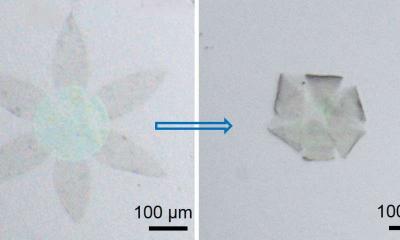Researchers with Johns Hopkins University and MIT have shown a way to cause flat sheets of graphene to self-fold into 3D geometric shapes. The group explains how they prepared the sheets and then used heat to cause them to fold. The ability to create 3D objects from sheets of graphene can advance opportunities in fields like sensors, wearables and more.

In their work, the researchers developed a micro-patterning technique that leads to the flat graphene sheets bending along predesignated lines when heat is applied, causing the sheet to form into shapes. The new method not only preserves the intrinsic properties of the graphene, but it was also found that the creases can cause a band gap in the graphene, which can be extremely useful.
In November 2015, scientists at Donghua University in China demonstrated a way to cause tiny (0.8 to 6 centimeter) graphene oxide-based objects to move in specific ways using heat and infrared light. The work was inspired by origami, an art form based on folding paper.

